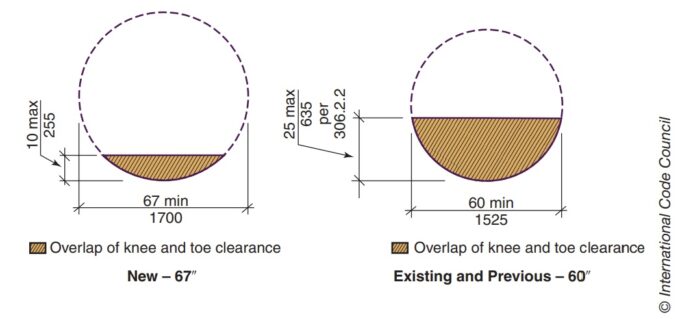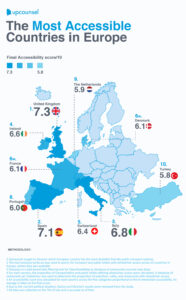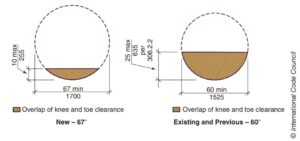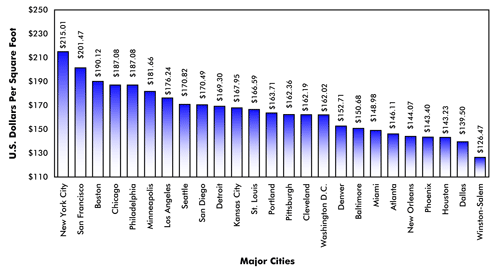ADA vs. ANSI: Understanding the Discrepancies in Accessibility Standards
Designing for accessibility is essential for both ethical and legal reasons. However, building professionals often face confusion between two key standards: ADA and ANSI A117.1. While both aim to create inclusive environments, they differ in scope, application, and enforcement. Understanding these differences is critical to reducing liability and avoiding costly mistakes.
At EVstudio, we closely follow both standards. We also recommend using third-party accessibility consultants to provide an additional layer of risk mitigation to potential legal consequences for owners and developers.

Why Multiple Accessibility Standards Exist
The Americans with Disabilities Act (ADA) is a federal civil rights law. Passed in 1990, it prohibits discrimination based on disability. The ADA applies to all public accommodations, commercial facilities, and certain housing types.
Meanwhile, ANSI A117.1 is a model accessibility standard developed by the International Code Council (ICC). It is not law by itself. However, it becomes enforceable when adopted by building codes like the IBC (International Building Code).
These two standards serve different legal purposes. ADA focuses on civil rights and usability. ANSI focuses on technical building code compliance. Because of this, they do not always align. And it is madness that our government doesn’t provide a safe harbor for owners and developers.
Key Discrepancies Between ADA and ANSI
Here are a few examples where ADA and ANSI conflict:
1. Clear Floor Space
-
ADA: Allows a 30″x48″ clear space that may overlap knee and toe clearance.
-
ANSI: Requires the space to be fully clear of obstructions in some cases.
-
Impact: Misinterpreting this could result in a non-compliant kitchen or restroom layout.
2. Reach Ranges
-
ADA: Permits higher reach ranges when an obstruction is present.
-
ANSI: Sets more restrictive maximums for forward and side reaches.
-
Impact: A wall-mounted device that complies with ADA may violate ANSI, or vice versa.
3. Turning Radius
-
ADA: Requires a 60-inch turning circle in most cases.
-
ANSI A117.1-2017: Requires a 67-inch circle in some instances.
-
Impact: Using the smaller radius may lead to significant redesign costs if the project falls under newer ANSI codes.
4. Accessible Routes
-
ADA: Prioritizes usability over strict measurement.
-
ANSI: Provides very specific gradient and slope criteria.
-
Impact: An exterior route might meet ADA but fail ANSI if slope transitions are not managed correctly.
How These Conflicts Create Legal Risk
When discrepancies arise, courts may side with the more stringent standard. If a facility meets local building code (ANSI) but fails ADA usability, it may still face lawsuits.
Developers and owners must understand that ADA is a minimum, not a design suggestion. Meeting ANSI does not guarantee ADA compliance. Conversely, meeting ADA does not guarantee building permit approval under IBC/ANSI.
How EVstudio Mitigates Accessibility Risk
EVstudio stays informed on ADA and ANSI changes. We attend code updates, follow federal rulings, and track IBC adoption by jurisdiction. Our teams are trained to identify discrepancies during the design phase—not after construction.
We also strongly recommend using a third-party accessibility consultant. These specialists provide code reviews, field verification, and documentation to support compliance. Engaging a consultant early reduces rework, ensures proper details, and provides stronger legal defense in the case of claims. It is a smart, proactive step for all building types.
Conclusion: Design with Clarity, Avoid Risk
Conflicts between ADA and ANSI standards are more than technical details. They can create serious financial and legal problems. By recognizing the differences early, design teams can make informed decisions that meet both standards.
At EVstudio, we design every project with accessibility in mind. Our approach combines knowledge, diligence, and trusted consulting partnerships to keep projects safe, inclusive, and compliant.
Resources:










